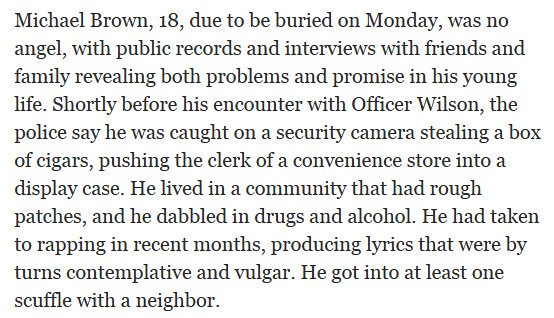On the eve of Michael Brown’s funeral, a New York Times profile of the slain youth called him “no angel” and characterized Brown as troubled, citing his experimentation with rap as evidence. Vociferous criticism quickly followed, with the Times‘ public editor, Margaret Sullivan, finally admitting that the language used to describe Brown was regrettable.
Much of the criticism focused on how race played an implicit role in the vilification of Brown – how his blackness provoked descriptions white victims of violent crime rarely see – as is often the case in American media.
In a stunning display, Sean McElwee took that critique one step further by contrasting Brown’s description not with those of other white victims of crime, but with a white perpetrator of violent crime – mass murderer Ted Bundy.
Below is a paragraph from the Times‘ profile of Brown published on August 24, 2014. It is preceded by evidence that the teenager who was gunned down by police, unarmed, was grappling with and deepening his spiritual beliefs.
Now, contrast the above characterization of Brown with that of mass murderer Ted Bundy in a profile published just after the State of Florida executed him on January 24, 1989. The paragraphs below were preceded by gruesome details of Bundy’s lethal methodologies.
The contrast is remarkable.
Also remarkable is that Bundy’s closing quote reverberates 25 years later in a completely different context, as the dehumanization and condemnation of an unarmed teenager gunned down by a rogue police officer continues.
Not because he was a horrible person. But because he was black.
-§-

David Harris-Gershon is author of the memoir What Do You Buy the Children of the Terrorist Who Tried to Kill Your Wife?, published recently by Oneworld Publications.
Follow him on Twitter @David_EHG.



McElewee cherry-picked one of the nicer parts of that Bundy story. He didn’t quote this part:
The killer, who stalked victims in the Pacific Northwest in the mid-1970’s terrorized several university communities, selecting coeds for abduction from campuses at night or crowded parks in daytime when their defenses were lowered in familiar settings….
He usually throttled them and then sexually abused and mutilated them before disposing of their bodies in remote areas. If the skeletons were found months or years later there was nearly always evidence of fractured skulls and broken jaws and limbs.
“This kind of mutilation reveals a hatred of the female body,” said Dr. David Abrahamsen a New York psychiatrist who is an authority on those who kill people in a series and is author of “The Murdering Mind.”
See my post on this:
http://nomoremister.blogspot.com/2014/08/no-new-york-times-did-not-portray-john.html
As another comment pointed out, the profile of Bundy also includes strongly negative descriptions of his gruesome deeds and behavior. And the NY Times profile of Brown included positive characterizations about deepening his spiritual beliefs. So as far as I’m concerned the “sad” contrast in descriptions from the NY Times is NOT proof of racism. If anything it’s showing a consistent position of playing a balanced form of devil’s advocate- pointing out that victims are not total angels and perpetrators are not total monsters. The race issue is (in this instance) irrelevant.